pilot

 My sister-in-law, Jennifer Parmely’s partner, Brian Cratty is probably as close as I’ll ever know to a true mountain man. No, he doesn’t live alone in the wilderness, but he probably could. He loves the mountains, loves spending countless hours up at their cabin on Casper Mountain or riding the biking trails, or watching the animals that live and roam through their property. Brian is totally in his element on the mountain. I’m sure that his love of the outdoors is a big part of the attraction for Jennifer. She is a serious outdoor woman too. They always have similar goals and ideas too.
My sister-in-law, Jennifer Parmely’s partner, Brian Cratty is probably as close as I’ll ever know to a true mountain man. No, he doesn’t live alone in the wilderness, but he probably could. He loves the mountains, loves spending countless hours up at their cabin on Casper Mountain or riding the biking trails, or watching the animals that live and roam through their property. Brian is totally in his element on the mountain. I’m sure that his love of the outdoors is a big part of the attraction for Jennifer. She is a serious outdoor woman too. They always have similar goals and ideas too.
Brian is a very compassionate, kind, and loving. He can usually read a situation and knows very well what  needs to be done to comfort people. That was really one of the first things I saw in him, when my father-in-law (Jennifer’s dad) passed away. He was there for her…a quiet strength. It was much appreciated by all of us. We all felt his compassion. That was such a hard day, as were the days following the loss of our other parents, but that day stood out in my mind, because he just made us all feel…loved.
needs to be done to comfort people. That was really one of the first things I saw in him, when my father-in-law (Jennifer’s dad) passed away. He was there for her…a quiet strength. It was much appreciated by all of us. We all felt his compassion. That was such a hard day, as were the days following the loss of our other parents, but that day stood out in my mind, because he just made us all feel…loved.
Brian is a good man. He plays with Jennifer’s grandchildren, making them feel special. He is a wonderful grandpa to them. I’m not sure what the kids call Brian, but in keeping with the German word for Grandma (Oma), I would assume it might be Opa. It doesn’t really matter, because the kids love him, and they have a great time with him. Brian is a person who gets along well with just about anyone, and kids pick up on that stuff too.
Brian has been a pilot for most of his life. He was a helicopter pilot in the US Army, from October 1968 to April 
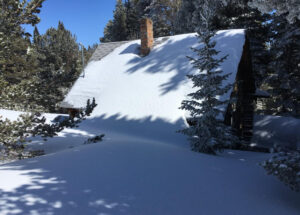 1971. Then when he got out of the Army, he became a Life Flight pilot at Wyoming Medical Center (Banner Health) from October 1984 to December 2006. When he left Banner Health, he flew for Business Aviators, Inc from December 2006 to 2015, when he retired. These days, he is still a pilot, but a lot of his “flying” is done on a bicycle. Today is Briam’s birthday. Happy birthday Brian!! Have a great day!! We love you!!
1971. Then when he got out of the Army, he became a Life Flight pilot at Wyoming Medical Center (Banner Health) from October 1984 to December 2006. When he left Banner Health, he flew for Business Aviators, Inc from December 2006 to 2015, when he retired. These days, he is still a pilot, but a lot of his “flying” is done on a bicycle. Today is Briam’s birthday. Happy birthday Brian!! Have a great day!! We love you!!

 My brother-in-law, Brian Cratty has been my sister-in-law, Jennifer Parmely’s partner since July 25, 2011, and theirs has been really a wonderful relationship. They love doing the same things, like skiing, hiking, bicycling, snowshoeing, and hanging out at their cabin on Casper Mountain. They met at Wyoming Medical Center, where they both worked…she as a labor and delivery nurse, and he as a life flight pilot. Brian is retired now, and Jennifer soon will be, so their real adventures are coming up very quickly.
My brother-in-law, Brian Cratty has been my sister-in-law, Jennifer Parmely’s partner since July 25, 2011, and theirs has been really a wonderful relationship. They love doing the same things, like skiing, hiking, bicycling, snowshoeing, and hanging out at their cabin on Casper Mountain. They met at Wyoming Medical Center, where they both worked…she as a labor and delivery nurse, and he as a life flight pilot. Brian is retired now, and Jennifer soon will be, so their real adventures are coming up very quickly.
Brian has been there for Jenifer in so many ways. He has been there for the low points in her life like when her parents passed away; and he has been there for the high points, like hiking Mount Elbert’s 14,473-foot summit. You don’t get more “lows and highs” than that. Through every part of their relationship, Brian has been there to love and support Jennifer, and the rest of the family 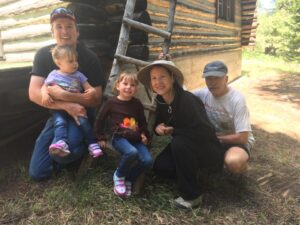 too. We have all grown to love him very much, and look to him as a brother, uncle, grandpa, and dad.
too. We have all grown to love him very much, and look to him as a brother, uncle, grandpa, and dad.
With their birthdays being so close together, Jennifer took this past week off, and the two of them made a trip to Colorado to have some fun…probably skiing, since Colorado had some new snow last week. They really do quite a bit of outdoor activities in Colorado, and I can understand why, because the Rocky Mountains have lots to do…for this fun loving, outdoor couple, even more to do than most people. While traveling is fun, I still think that their favorite place to be is on Casper Mountain at their cabin. It was pretty rustic when they bought it from a friend who, for health reasons, was unable to go there again, and moved to a warmer climate. When they bought it, the cabin was little more than a glorified tent. The interior needed lots of work. Brian and Jennifer have worked really hard to make it into the getaway they want, and I can say that it looks a lot better now. The land around it is much better too, and when they are at the cabin, they are close to some of the trails they love. Brian is probably more of a bicycler than Jennifer is, even though she loves to ride too. He will ride for hours on the mountain trails. Sometimes when the rest of the 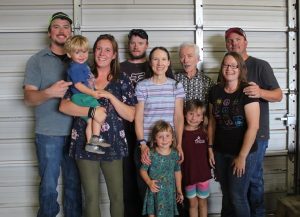
 family are hiking, they cross paths with Brian on his bicycle.
family are hiking, they cross paths with Brian on his bicycle.
Brian is a licensed pilot, and I sometimes wonder if he misses that part of his life. I know he could fly planes for people if he wanted to, but that would put him on someone else’s timeline again, and that is something most of us retired people don’t want to do. So, Brian spends his time doing the things he loves, and that suits him just fine. Today is Brian’s birthday. Happy birthday Brian!! Have a great day!! We love you!!
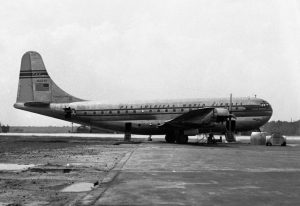 Pan American World Airways Flight 845/26, a Boeing 377 Stratocruiser, Clipper United States, N1032V departed from Seattle-Tacoma Airport (SeaTac) on March 26, 1955 at 8:15am…a Saturday morning, destined for Sydney, Australia, with stops at Portland, Oregon and Honolulu, Hawaii. Following its stop in Portland (PDX), the plane took off at 10:21am, with a crew of 8 and 15 passengers on board. It looked to be an easy flight to Hawaii, with plenty of onboard staff to make the trip enjoyable for the passengers. The plane was piloted by Captain Herman Joslyn, with First Officer Angus Gustavus Hendrick Jr; Second Officer Michael Kerwick; Flight Engineer Donald Read Fowler; and Assistant Flight Engineer Stuart Bachman. In the passenger cabin were Purser Natalie Parker, Stewardess Elizabeth Thompson, and Steward James Peppin.
Pan American World Airways Flight 845/26, a Boeing 377 Stratocruiser, Clipper United States, N1032V departed from Seattle-Tacoma Airport (SeaTac) on March 26, 1955 at 8:15am…a Saturday morning, destined for Sydney, Australia, with stops at Portland, Oregon and Honolulu, Hawaii. Following its stop in Portland (PDX), the plane took off at 10:21am, with a crew of 8 and 15 passengers on board. It looked to be an easy flight to Hawaii, with plenty of onboard staff to make the trip enjoyable for the passengers. The plane was piloted by Captain Herman Joslyn, with First Officer Angus Gustavus Hendrick Jr; Second Officer Michael Kerwick; Flight Engineer Donald Read Fowler; and Assistant Flight Engineer Stuart Bachman. In the passenger cabin were Purser Natalie Parker, Stewardess Elizabeth Thompson, and Steward James Peppin.
The flight was proceeding as normal, until it hit 10,000 feet, at which point a severe vibration lasting 5 to 8 seconds began. The Number 3 engine, which is on the right side, on the inside, suddenly ripped away from the starboard wing. The damage to the wing caused severe shaking. At the same time, the nose pitched down and the airspeed increased rapidly. Captain Joslyn immediately reduced engine power slow the plane down some, but they were losing altitude rapidly, quickly dropping by 5,000 feet. The damage cause by the engine ripping away included damage to the engines’ electrical system, and the flight engineer was not able to increase power on the remaining three engines. Without the added power on the remaining engines, the Stratocruiser was too heavy at this early stage in the flight to maintain its altitude. She still had too much fuel onboard to compensate. The Stratocruiser was doomed, and there was nowhere to land.
The flight crew ditched the Stratocruiser into the north Pacific Ocean at 11:12am, approximately 35 miles west of the Oregon coastline. The conditions were ideal for ditching, with smooth seas and little wind, but it was a hard impact. As the plane hit the water, seats were torn loose, and several occupants were injured. Nevertheless, no one was killed and evacuation began immediately with the inflation of all three life rafts. The water temperature was 47° F, so getting out of the water was essential. Soon after the crash, a North American Aviation F-86F Sabre flown by Captain W L Parks, 142nd Fighter Interceptor Group, Oregon Air National Guard, located the scene of the ditching. When he saw the smoke flares that had been released, he was able to see the two life rafts tied together. A Lockheed Constellation also rushed to the scene from the south. After confirming that Air Force rescue aircraft were on the way, Captain Parks returned to Portland, because he was low on fuel.
Among the injured was the airliner’s purser, Natalie Parker, who had been assisting passengers with their life vests and seat belts when the airliner hit the water. Because she was standing in the aisle, she was thrown forward, knocking down five rows of seats as she hit them. She was badly bruised and suffering from shock. Nevertheless, Parker assisted the passengers in abandoning the sinking Stratocruiser. When everyone was off, she enter the water and saw that some of the injured had begun to drift away. In an amazing act of bravery and duty, and suffering from shock, Parker swam out and towed the only seriously injured passenger to the nearest raft, some 200 feet away. The Stratocruiser floated for an amazing 20 minutes before sinking. While all survived the impact, four of the 23 persons on board, passengers John Peterson, David Darrow, First Officer Hendrick, and Flight Engineer Fowler, died of injuries and exposure. The survivors were rescued after two hours by the crew of USS Bayfield (APA-33), a United States Navy attack transport.
During the Civil Aeronautics Board hearings into the accident, Vice Chairman Joseph P. Adams commended Natalie Parker, the flight’s purser, “. . . all of us feel inspired that a fellow citizen, or just a fellow human being, can rise to such an occasion in the manner in which you did. It is most commendable, Miss Parker.” The exact cause of the loss of the Stratocruiser was not fully determined, because the engine and propeller were not recovered. Th investigation assumed that the most likely cause was a fracture of a propeller blade resulting in a severely unbalanced condition, causing the violent separation of the engine from the wing. This was the fifth time that a Boeing 377 Stratocruiser had lost an engine following the failure of a hollow-steel Hamilton Standard 2J17 propeller blade. Further complicating the matter, was the flight engineer’s attempt to increase the propeller rpm on the three engines simultaneously. That caused an electrical overload occurred which opened the master circuit breaker. This prevented any engine power increase, effectively bringing down the Stratocruiser.
 Most of us have learned of the event that brought the United States into World War II…the attack on Pearl Harbor. The United States was caught totally unaware, even though the signs were there, and even some chatter was heard. Nevertheless, our ships were sitting in the harbor, with many of the men not on board, and our planes were sitting on the tarmac. The plan the Japanese had was to wipe out the US military machine, so that the United States was virtually out of the war. The mistake the made was that they misjudged the United States. Nevertheless, on December 7, 1941, the attack on Pearl Harbor was a battle the United States lost.
Most of us have learned of the event that brought the United States into World War II…the attack on Pearl Harbor. The United States was caught totally unaware, even though the signs were there, and even some chatter was heard. Nevertheless, our ships were sitting in the harbor, with many of the men not on board, and our planes were sitting on the tarmac. The plan the Japanese had was to wipe out the US military machine, so that the United States was virtually out of the war. The mistake the made was that they misjudged the United States. Nevertheless, on December 7, 1941, the attack on Pearl Harbor was a battle the United States lost.
There were heroes on that day, however. The people who worked to save what lives they could, and put out the fires caused by the attack. And there were two heroes I had never heard about. I’m not sure why I hadn’t, but the fact remains that I hadn’t. Kenneth Taylor and George Welch were pilots stationed at Pearl Harbor on that fateful day. Taylor was a second lieutenant in the US Army Air Corps’ 47th Pursuit Squadron. He received his first posting to Wheeler Army Airfield in Honolulu, Hawaii in April 1941. His commanding officer, General Gordon Austin, chose Taylor and another pilot, George Welch, as his flight commanders shortly after they arrived in Hawaii. A week before the Japanese attack on Pearl Harbor, the 47th Pursuit Squadron was temporarily moved to the auxiliary airstrip at Haleiwa Field, located some 11 miles from Wheeler, for gunnery practice…a move that made their response to the attack possible.
Saturday, December 6, 1941, found Taylor and Welch spending the evening at a dance held at the officers’ club at Wheeler Field. After the dance, the two pilots joined an all-night poker game. After that, the account of the story gets a little fuzzy. Some said that the two pilots had finally gone to sleep, and were awoken only around 7:51am, when Japanese fighter planes and dive bombers attacked Wheeler, but others said that the poker game was just wrapping up, and they were contemplating a morning swim when the attack began. Whatever the case may be, Taylor and Welch were stunned to hear low-flying planes, explosions, and machine-gun fire above them. Information was scarce in all the chaos, but they learned that two-thirds of the planes at the main bases of Hickham and Wheeler Fields had been destroyed or damaged so badly that they were unable to fly. The two men rush to Haleiwa Field to get their planes. They had no orders, but Taylor called Haleiwa and  commanded the ground crew to prepare their Curtiss P-40 Tomahawks for takeoff, while Welch ran to get Taylor’s new Buick. The men were still wearing their tuxedo pants from the night before, but that didn’t stop them. The two pilots drove the 11 miles to Haleiwa, reaching speeds of 100 miles per hour along the way.
commanded the ground crew to prepare their Curtiss P-40 Tomahawks for takeoff, while Welch ran to get Taylor’s new Buick. The men were still wearing their tuxedo pants from the night before, but that didn’t stop them. The two pilots drove the 11 miles to Haleiwa, reaching speeds of 100 miles per hour along the way.
When they reached the field, Welch and Taylor jumped into their P-40s, which by that time had been fueled but not fully armed. That didn’t stop them. They took off and immediately attracted Japanese fire. Welch and Taylor were facing off virtually alone against some 200 to 300 enemy aircraft. When they ran out of ammunition, they returned to Wheeler to reload. The senior officers ordered the pilots to stay on the ground, but then
the second wave of Japanese raiders flew in, scattering the crowd. Taylor and Welch took off again, in the midst of a swarm of enemy planes. Though Welch’s machine guns were disconnected, he fired his .30-caliber guns, destroying two Japanese planes on the first attack run. On the second, with his plane heavily damaged by gunfire, he shot down two more enemy aircraft. A bullet pierced the canopy of Taylor’s plane, hitting his arm and sending shrapnel into his leg, but he managed to shoot down at least two Japanese planes, and perhaps more. In the end, Taylor was officially credited with two kills, and Welch with four.
Welch and Taylor were among only five Air Force pilots who managed to get their planes off the ground and engage the Japanese that morning. The total loss in aircraft at Pearl Harbor were estimated at 188 planes destroyed and 159 damaged. The Japanese lost just 29 planes. Both men were awarded the Distinguished Service Cross medals, becoming the first to be awarded that distinction in World War II. Welch was nominated for the Medal of Honor, the military’s highest award, but was reportedly denied because his superiors maintained he had taken off without proper authorization. For his injuries, Taylor received the Purple Heart.
After Pearl Harbor, George Welch flew nearly 350 missions in the Pacific Theater during World War II, shooting down 12 more planes and winning many other decorations. After he contracted malaria in 1943, his wartime career came to an end. While in the hospital in Sydney, Australia, he met his wife. After the war, Welch became a test pilot for North American Aviation. There are some claims that he became the first pilot to break the Mach-1 barrier with an unauthorized flight over the California desert in 1947, several weeks before Chuck Yeager’s famous flight. Unfortunately, Welch was killed in 1954 while ejecting from his disintegrating F-100 Super Sabre fighter jet during a test flight.

After Pearl Harbor, Ken Taylor was transferred to the South Pacific, where he flew out of Guadalcanal and was credited with downing another Japanese aircraft. Unfortunately, his combat career was cut short after someone fell on top of him in a trench during an air raid on the base, breaking his leg. He became a commander in the Alaska Air National Guard and retired as a brigadier general after 27 years of active duty. Taylor was awarded the Distinguished Service Cross, the Legion of Merit, the Air Medal, and a number of other decorations. In his post military career, he worked as an insurance underwriter. Taylor died in Tucson, Arizona in 2006, at the age of 86.
 In a war, the point is to kill the enemy, or be killed by the enemy. There is no room for soft hearts and compassion…or is there? On December 20, 1943, Charlie Brown, an American B-17 bomber pilot and his crew attempted to bomb an aircraft production facility in Bremen, Germany, as part of a bombing run with a squadron of B-17s. Unfortunately, the interior areas of Germany were better fortified with anti-aircraft guns. As the bombing run reached the factory, and dropped the payload, the 250 anti-aircraft guns which surrounded the factory were fired. Charlie Brown’s B-17, Ye Olde Pub, was hit, disabling two engines and forcing the plane out of formation. It was the habit of the German fighter planes to go after any stragglers, knowing that they were the weaker link. Brown’s damaged B-17 was chased down and several of the crew members were seriously wounded. The hit also knocked out all but one of the plane’s engines.
In a war, the point is to kill the enemy, or be killed by the enemy. There is no room for soft hearts and compassion…or is there? On December 20, 1943, Charlie Brown, an American B-17 bomber pilot and his crew attempted to bomb an aircraft production facility in Bremen, Germany, as part of a bombing run with a squadron of B-17s. Unfortunately, the interior areas of Germany were better fortified with anti-aircraft guns. As the bombing run reached the factory, and dropped the payload, the 250 anti-aircraft guns which surrounded the factory were fired. Charlie Brown’s B-17, Ye Olde Pub, was hit, disabling two engines and forcing the plane out of formation. It was the habit of the German fighter planes to go after any stragglers, knowing that they were the weaker link. Brown’s damaged B-17 was chased down and several of the crew members were seriously wounded. The hit also knocked out all but one of the plane’s engines.
Thinking the plane was doomed, the fighters turned their attention to other prey. Meanwhile, Ye Olde Pub tried to limp along toward England, hoping not to be spotted. Of course, they knew their hope of escape was quite unlikely, and before long they were spotted by German fighter pilot Franz Stigler, who was refueling. Stigler jumped into his plane and took off, catching up with the wounded plane quickly. Stigler was about to blast the plane, when he saw that the crew was seriously wounded. Stigler, a combat veteran with 22 confirmed kills, was reluctant to attack a defenseless aircraft, so instead pulled alongside the B-17 cockpit and signaled the crew to land. They refused. He then motioned in the direction of Sweden, which would get them on the ground, but also take them out of the war. It didn’t really matter, because the Allied crew didn’t understand.
Unable to convince them to land, but also unwilling to leave them, Stigler flew side-by-side with the stricken bomber, even though he was afraid his own plane might identify him, and his actions might get him executed. As Brown’s B-17 approached the safety of the English Channel, Stigler saluted and peeled off…not really expecting the B-17 to make it safely home. Miraculously, Brown kept the plane in the air and made it to England. Brown  often wondered why Stigler hadn’t shot him down, but never expected to know who the unknow German fighter pilot was. Nevertheless, after the war, Brown placed an ad in a World War II newsletter for pilot veterans. Amazingly, Stigler, who had relocated to Canada, saw the ad. The two pilots reunited, both still in shock to see the other, and when Brown ask the question that had been burning in his mind for years…why didn’t Stigler shoot them down? Stigler explained that to shoot at them would have been dishonorable. Charlie Brown was shocked to know that even among the enemy, there could exist such compassion. The two pilots immediately felt like they were forever connected. They remained close friends until their deaths in 2008.
often wondered why Stigler hadn’t shot him down, but never expected to know who the unknow German fighter pilot was. Nevertheless, after the war, Brown placed an ad in a World War II newsletter for pilot veterans. Amazingly, Stigler, who had relocated to Canada, saw the ad. The two pilots reunited, both still in shock to see the other, and when Brown ask the question that had been burning in his mind for years…why didn’t Stigler shoot them down? Stigler explained that to shoot at them would have been dishonorable. Charlie Brown was shocked to know that even among the enemy, there could exist such compassion. The two pilots immediately felt like they were forever connected. They remained close friends until their deaths in 2008.
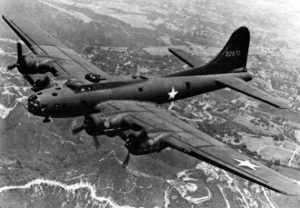 Strange things have been known to happen over the centuries of Earth’s existence. Most end up being clearly explained. Some are explained, but few people believe the explanation, and still others are forever mysteries…destined to have no possible explanation. People, especially those who witness the event, just know that it did happen. Often, wars are filled with strange stories. Everything from bombs killing everyone in an area, except for one lone old woman; to enemy soldiers allowing a soldier to go free, even though the enemy clearly had the upper hand. Of course, some mysteries defy any possible explanation. Such is the case of the Phantom Fortress. If one looks there can be found all manner of oddities and anomalies scattered in the background of the more sensational news of the fighting of a war, coming from land, air, and sea. From ghost ships found floating in the oceans years after they were last seen, their crews mysteriously missing, with no sign of violence or death on board. Of course, the stories run wild, sighting every possibility from UFOs; to disappearance to another dimension; to desertion, though hard to explain, when no trace of the crew ever showed up anywhere else. Still, few were more strange than the Phantom Fortress.
Strange things have been known to happen over the centuries of Earth’s existence. Most end up being clearly explained. Some are explained, but few people believe the explanation, and still others are forever mysteries…destined to have no possible explanation. People, especially those who witness the event, just know that it did happen. Often, wars are filled with strange stories. Everything from bombs killing everyone in an area, except for one lone old woman; to enemy soldiers allowing a soldier to go free, even though the enemy clearly had the upper hand. Of course, some mysteries defy any possible explanation. Such is the case of the Phantom Fortress. If one looks there can be found all manner of oddities and anomalies scattered in the background of the more sensational news of the fighting of a war, coming from land, air, and sea. From ghost ships found floating in the oceans years after they were last seen, their crews mysteriously missing, with no sign of violence or death on board. Of course, the stories run wild, sighting every possibility from UFOs; to disappearance to another dimension; to desertion, though hard to explain, when no trace of the crew ever showed up anywhere else. Still, few were more strange than the Phantom Fortress.
On November 23, 1944, a British Royal Air Force anti-aircraft unit stationed near Cortonburg, Belgium was suddenly surprised to see an American Army Air Corps B-17 bomber, nicknamed the “Flying Fortress,” heading in their direction. Because there was no such landing scheduled and because of the speed of the incoming aircraft it was assumed that it was preparing to make an emergency landing at the base. Still, after checking with the base tower, it was confirmed that that no such B-17 landing was expected. Be that as it may, this plane was coming in for a landing, so the gunner crew watched helplessly as the massive aircraft came hurtling in towards a nearby open, plowed field.
No matter what standards you use, this landing was a messy one to say the least. The plane bounced and swerved along as the terrified gunners looked on. It finally came to a stop dangerously close to their position after one of its wings clipped the ground. Nevertheless, it was still in one piece and had not actually crashed, but it was an incredibly rough landing. The stunned gunners watched as the aircraft sat there looming over the field, its propellers continuing to spin. The minutes ticked by, but no one exited the plane. After waiting 20 minutes with no sign of human activity, and the plane just sitting there with its engines running, the gunner crew decided to go in and investigate. They had no idea what kind of a scene awaited them inside, but what they found, they never could have guessed. Upon opening the entry hatch under the fuselage, they entered. The gunner crew expected that the crew had been injured or was otherwise unable to get out of the plane, but what they found was that the plane was completely empty. Unable to believe what they had just witnessed, especially in light of the empty plane, the gunner crew made a full sweep through the aircraft. The gunner crew reported that it looked like the crew had just recently been there and must have left the aircraft in a hurry. They found chocolate bars unwrapped and half eaten lying about, a row of neatly folded parachutes, with none apparently missing, and jackets that had been neatly hung up.
The superior officer, a John V. Crisp, would say of the eerie scene, “We now made a thorough search and our most remarkable find in the fuselage was about a dozen parachutes neatly wrapped and ready for clipping on. This made the whereabouts of the crew even more mysterious. The Sperry bomb-sight remained in the Perspex nose, quite undamaged, with its cover neatly folded beside it. Back on the navigator’s desk was the code book giving the colours and letters of the day for identification purposes. Various fur-lined flying jackets lay in the fuselage together with a few bars of chocolate, partly consumed in some cases.” Crisp found himself in an awkward position. He knew what he was seeing. He knew that he would have to write up the report on the incident. And most importantly, he knew that his men were looking to him for answers. Where had the crew of the “Phantom Fortress” gone and how had the plane landed on its own? This was not during a time when planes could be programed to land. No one had any idea how this could have come to pass. Crisp told the men to shut the engines down, and they inspected the planes interior further. The men looked for anything that might provide answers. The log book was found opened, and the last cryptic words written in it were “bad flak.” Yet, all of the parachutes seemed to be accounted for and the exterior of the plane did not have evidence of flak damage, or any damage except for what it had incurred in its rough landing, such as the buckled wing and one disabled engine. The log entry just seemed strange considering.
The B-17’s crew was eventually found, alive and well. For their side, they said, “They changed their course towards Brussels, Belgium, at the same time making the plane lighter by dumping and jettisoning any unnecessary or nonessential equipment on board. When the plane still continued to suffer and a second engine on the struggling plane sputtered out, it was decided that the aircraft would be unable to make the journey, and the crew had then decided to bail out. The B-17 was put on autopilot and left to its fate as the crew jumped to safety. No one thought it would make it very far, let alone somehow land, but land it did.” It seemed as if they honestly thought they had been in battle, and even more, that they had bailed out, with parachutes that were miraculously replaced. Still, why did ground crew report all 4 engines working as the bomber had approached, with one being damaged only upon landing, when the report said that 2 engines had been knocked out during the mission? Where was the damage from the claimed enemy fire? Perhaps most mysterious of all, how had a large, cumbersome plane like the B-17 manage to come to a landing without a pilot?
Authorities on the case, as well as crew members of the Phantom Fortress, suggested some theories to explain the mysteries surrounding the event. For instance, with the engines it could have been that the technical difficulties cleared up on their own after the crew had bailed out, making the plane seem to have 4 fully operating engines on approach, although why they would start working again after being taken out remains mysterious. If the engines had been in bad enough shape for the crew to abandon the aircraft it seems odd that they should kick back into working order on their own and continue whirring away even after the rough landing. As to the lack of any apparent visible damage from enemy fire, the gunner crew could have simply missed the damage due to the untrained eyes of the team that initially investigated the plane after it had landed. They were just a gunner crew, not trained aviators, and may have mistaken the damage reported by the B-17 crew as being from the crash. They might not have noticed that the aircraft had sustained battle damage, but then again they were anti-aircraft gunners and might have had some idea. With the parachutes, it was surmised that they had possibly mistaken some spare parachutes as the full compliment. However, this is all speculation, and the mystery has never been totally solved. Still, the biggest mystery simply cannot be explained away. How did the B-17 come to a landing mostly intact without a pilot? Autopilot is one thing, but landing is another beast altogether. As the saying goes, “Flying is easy, landing is hard.” A pilotless B-17 landing by itself with no one on board was unprecedented. It should have careened into the ground to crash into a ball of fire and debris, or at least ended up a heap of twisted wreckage. So how could this happen?
Although no one really knows for sure, the main theory is “that the plane simply lost altitude slowly, at just the right speed, and with just the right angle of descent to come down relatively softly enough to appear as if it was landing, with the B-17’s legendary toughness and sturdy frame managing to hold it together to keep it from disintegrating.” To this, I say, “Come on!! Get serious!!” The odds of all of this happening in just such a way is all but impossible. Also, there is the rather odd detail that this unmanned plane just happened to come 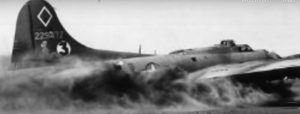 down in the exact best place to land under the circumstances, in that wide open field, and not one of the countless other places it could have come down more tragically. Its just too odd. Nevertheless, the mystery landing of the “Phantom Fortress” did happen. The details of how it did remain mysterious and open to speculation. What we do know for sure is that this B-17 was on a bombing mission in Germany, that it did land without a crew in that field, and that the crew members were later found to have been alive and well with quite a story to tell.
down in the exact best place to land under the circumstances, in that wide open field, and not one of the countless other places it could have come down more tragically. Its just too odd. Nevertheless, the mystery landing of the “Phantom Fortress” did happen. The details of how it did remain mysterious and open to speculation. What we do know for sure is that this B-17 was on a bombing mission in Germany, that it did land without a crew in that field, and that the crew members were later found to have been alive and well with quite a story to tell.
 The pilots of the war birds were brave men. They were tasked with staying the course while under heavy anti-aircraft fire and flak. That would be a major undertaking for most of us because in that situation, all our mind can think to do is to turn and run. These men had to stay in place so they could make the bomb runs, or protect those who were. Of course, there were gunners tasked with keeping the enemy planes at bay, but they couldn’t fly the plane to get you home.
The pilots of the war birds were brave men. They were tasked with staying the course while under heavy anti-aircraft fire and flak. That would be a major undertaking for most of us because in that situation, all our mind can think to do is to turn and run. These men had to stay in place so they could make the bomb runs, or protect those who were. Of course, there were gunners tasked with keeping the enemy planes at bay, but they couldn’t fly the plane to get you home.
United States Army Air Force Lieutenant William R Lawley Jr, was a pilot on a B-17 Bomber on February 20, 1944. It was the first day of “Big Week,” and Lieutenant Lawley’s Boeing B-17 Flying Fortress was at the head of a formation of one thousand bombers sent to bomb Germany’s production and aircraft manufacturing facilities. “Big Week” was the Allied plan to spend seven days ruthlessly dropping explosives onto enemy aircraft production facilities deep behind enemy lines. Day and night, wave after wave of American B-17 Flying Fortresses, B-24 Liberators, and British Lancasters blasted shipyards, railroad junctions, power plants, airfields, steel production facilities, dams, and military bases relentlessly, igniting everything from ball bearing plants to oil refineries up into towering explosive fireballs, to make it impossible for anyone in Germany to build a working fighter plane.
Suddenly, the call rang out, “Bandits, incoming, three o’clock high!” Immediately, the gunners began shooting to fight off the enemy planes, while Lawley held the plane steady. The loud, rumbling propellers roared as he pushed open the throttle and smashed through a thick black cloud of anti-aircraft smoke at nearly three hundred miles an hour, all while keeping in tight formation with hundreds of other B-17s. A pair of Nazi Focke-Wulf 190 fighter planes screamed by, ripping off thousands of rounds from twin-linked machine guns and heavy 20mm autocannons. Black puffs of enemy artillery popped up all around Lawley’s massive aircraft craft. The enemy fighters screamed past at speeds of over four hundred miles an hour. As the gray Nazi fighters dove down towards another squadron of American bombers below, Lawley’s starboard waist gunner zeroed in on them with his .50-caliber machine gun with a quick burst of tracer fire, but had to release the trigger as a pair of American P-47 Thunderbolt fighter planes dropped in to chase them. These Bomber raids were nothing new for Lawley. Born in Alabama, this 23 year old veteran pilot had already flown nine missions over Germany in the last year. This was his tenth mission, but the first at the controls of a brand-new B-17, nicknamed Cabin in the Sky III, because the first two Cabin in the Sky aircraft been blown up.
Suddenly, voices on the intercom called out enemy fighters, this time diving down from behind. With the sun at their backs, blinding the tail gunner, the Focke-Wulfs ignored the deadly clouds of flak ripping apart the sky around them and hurtled straight into the B-17 formation. Their 20mm cannons struck home at one of Lawley’s wingmen, catching her engines on fire and dropping her out of the sky like a brick. Another flak explosion hit even closer, rocking Cabin in the Sky III and peppering one of the engines with shards of metal, causing it to burst into flames. Lawley ordered the copilot to shut it down and kept moving. More calls came in. “Six o’clock low.” “Three o’clock level.” The Nazis were everywhere, attacking from seemingly every direction at once. The B-17s stuck close together, knowing that the only way to survive was to stay close and lay down heavy fields of  machine gun fire. As his gunners fired in every direction, Lawley looked through his cockpit window to see a fleet of twenty or so 190s drop down in front of him, pick out targets, and open fire. With a deafening crash, a 20mm high explosive autocannon shell bust through the front window of the pane, exploding in the cockpit. Everything went black.
machine gun fire. As his gunners fired in every direction, Lawley looked through his cockpit window to see a fleet of twenty or so 190s drop down in front of him, pick out targets, and open fire. With a deafening crash, a 20mm high explosive autocannon shell bust through the front window of the pane, exploding in the cockpit. Everything went black.
Lawley snapped awake seconds later, his ears ringing. Alarms were going off all across his console, which was now riddled with shards of shrapnel. His right arm was shattered. Through blurry vision, Lawley saw his co-pilot slumped over dead, his body laying on the control stick pushing it forward, putting the plane was in a steep dive. The loaded bomb racks made matters worse. The pilot-side window was smashed, and broken glass had gone into Lawley’s face, arms, and side. The windshield was so smeared with blood and oil that he could barely see out of it. Another engine was one fire. Lieutenant William Lawley didn’t panic. He did his job. Determined to keep his plane and his crew alive, the veteran USAAF pilot reached out with his shattered right arm, grabbed his dead co-pilot, and somehow pulled him back off the controls. Then, with just his left hand, he manually fought a 15-ton bomber aircraft out of a ninety-degree nosedive at 12,000 feet, leveled it off, and shut down the second burning engine. Looking up, he saw the Focke-Wulf pilots circling around for another pass, so this grim warrior made an evasive turn, dove the plane down into the cloud cover, and accelerated out of there as fast as he could. Other B-17s in the formation had radioed Cabin in the Sky III as Killed in Action, but somehow William Lawley managed to evade the enemy fighters and get the heck out of Leipzig. He flew across Germany, dodging enemy AA positions, then flew in low over the French countryside and ordered the surviving eight members of his crew to grab parachutes and bail out. It was then that he learned all eight crewmen were wounded in the attack, and that two of them were hurt so bad they couldn’t possibly go skydiving right now. Lawley said, “Ok. I’m going to get us home then.” Nobody jumped out of the plane.
The bombardier eventually got the racks unstuck and released his bombs over an unimportant part of the French countryside, but before long another squadron of Me-109 fighters picked up the wounded B-17 on radar and came swooping in for the kill. With his guys running to their guns to bark .50-caliber machine gun fire, Lawley hammered the stick of his crippled plane, dodging and evading with one arm and somehow eluding enemy fighters one more time. In the process, however, he had to use more fuel than he’d have liked, and one of the two remaining engines was now almost completely out of gas. Once the coast was clear and the Messerschmitt fighter planes were gone, Lawley leveled off the plane and promptly passed out from loss of blood. This was the days before autopilot, and Lawley was the only guy who knew how to fly the plane. Luckily his navigator figured out what was up and woke him up pretty much right away.

Cabin in the Sky III somehow reached the English Channel against all odds, received emergency landing permission from a Canadian fighter base on the English coast and, just in case you’re wondering how the heck this could possibly get any worse, when William Lawley hit the button to drop his landing gear, it didn’t deploy. So, limping in with three burned-out engines, “feathering” his only working one by pumping it off and on with small amounts of gas, half blinded by broken glass, exhausted from loss of blood, and with no landing gear, eight wounded crew members, and one good arm, Lieutenant William Lawley attempted to crash land a 15-ton B-17 on a grass airfield about the size of a soccer pitch. He came in hard on his belly, sliding across the airfield, finally coming to a rest just outside the Canadian barracks. Every member of his crew survived. Lawley walked out of the wreckage, spend a few weeks in the hospital, and make a full recovery. He successfully piloted four more bombing missions before the war was over. Did he earn his Modal of Honor? Without a doubt!!
 Sometimes, you meet the love of your life the second time around. That’s how it was for my sister-in-law, Jennifer Parmely when she met her other half, Brian Cratty. These two are so much alike that they practically finish each other’s sentences. They have the same goals and they are going in the same direction with their lives. They have been a blessing in each other’s lives, and it is a sweet thing to watch.
Sometimes, you meet the love of your life the second time around. That’s how it was for my sister-in-law, Jennifer Parmely when she met her other half, Brian Cratty. These two are so much alike that they practically finish each other’s sentences. They have the same goals and they are going in the same direction with their lives. They have been a blessing in each other’s lives, and it is a sweet thing to watch.
Brian is rather a quiet guy, with a kind and loving spirit. I think he is most at home seated on his bicycle, weaving back an forth over the mountain trails. Brian and  Jennifer have a friend who owned a cabin on Casper Mountain, and then moved away. While he was gone, he asked them to keep an eye on his cabin, and in exchange, they could use it whenever they wanted. They jumped at the chance, and when their friend decided to sell the cabin, he offered it to them, and they were delighted to buy it. Anyone who has owned a cabin on the mountains, know that there is always this or that improvement to do, and so Brian and Jennifer have been doing lots of updates to it so that they and their family can enjoy the beautiful scenery of Casper Mountain. Since they bought the cabin, it is their home away from home…when they aren’t traveling, that is.
Jennifer have a friend who owned a cabin on Casper Mountain, and then moved away. While he was gone, he asked them to keep an eye on his cabin, and in exchange, they could use it whenever they wanted. They jumped at the chance, and when their friend decided to sell the cabin, he offered it to them, and they were delighted to buy it. Anyone who has owned a cabin on the mountains, know that there is always this or that improvement to do, and so Brian and Jennifer have been doing lots of updates to it so that they and their family can enjoy the beautiful scenery of Casper Mountain. Since they bought the cabin, it is their home away from home…when they aren’t traveling, that is.  Brian and Jennifer love to travel to areas of the United States where they can find new trails to hike and bike…as well as seeing the local sights.
Brian and Jennifer love to travel to areas of the United States where they can find new trails to hike and bike…as well as seeing the local sights.
Brian is a licensed pilot, but I don’t know how much flying he does these days. I’m sure it is enough to keep his license in place. He was a pilot for the Wyoming Medical Center until his retirement from there, but as any pilot would say, flying is in your blood, and you fly every chance you get. He has done corporate flying, but I think he just likes being retired for the most part. Today is Brian’s birthday. Happy birthday Brian!! Have a great day!! We love you!!
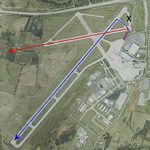
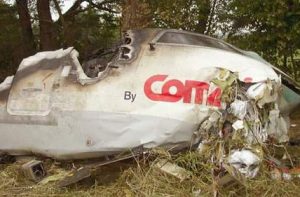 Following instructions and paying close attention to those instructions are crucial to the safe operation of a plane, especially at take offs and landings. When the pilot of Comair Flight 5191 taxied to the runway of his takeoff, something went horribly wrong. He was told to proceed to Runway 22, but he turned one lane too early, and ended up taking off on Runway 26, which was too short for a safe take off of a plane of that size. Comair 1591, was a CRJ-100ER plane that was carrying 47 passengers and 3 crew members. Instead of using runway 22 as expected, they used runway 26 which had too short of a path for a safe takeoff, even though Captain Jeffrey Clay confirmed using runway 22. He inadvertently took a left too early according to the map. At Blue Grass Airport in Lexington, Kentucky, on August 27, 2006, 49 of the 50 passengers and crew died while taking off from the airport. It’s hard to say at what point the pilot knew he was in trouble, but as the plane reached the end of the runway, they knew that there had not been enough time to gt the plane up to speed,and they simply couldn’t get enough lift to get it safely in the air. “They must have almost cleared the fence because only the top of it was missing and then the tips of some trees further out were also burnt off,” said Nick Bentley, who owns the 115-acre farm where the plane crashed, referring to an 8-foot metal fence that separates his property from the airport’s 3,500-foot runway.
Following instructions and paying close attention to those instructions are crucial to the safe operation of a plane, especially at take offs and landings. When the pilot of Comair Flight 5191 taxied to the runway of his takeoff, something went horribly wrong. He was told to proceed to Runway 22, but he turned one lane too early, and ended up taking off on Runway 26, which was too short for a safe take off of a plane of that size. Comair 1591, was a CRJ-100ER plane that was carrying 47 passengers and 3 crew members. Instead of using runway 22 as expected, they used runway 26 which had too short of a path for a safe takeoff, even though Captain Jeffrey Clay confirmed using runway 22. He inadvertently took a left too early according to the map. At Blue Grass Airport in Lexington, Kentucky, on August 27, 2006, 49 of the 50 passengers and crew died while taking off from the airport. It’s hard to say at what point the pilot knew he was in trouble, but as the plane reached the end of the runway, they knew that there had not been enough time to gt the plane up to speed,and they simply couldn’t get enough lift to get it safely in the air. “They must have almost cleared the fence because only the top of it was missing and then the tips of some trees further out were also burnt off,” said Nick Bentley, who owns the 115-acre farm where the plane crashed, referring to an 8-foot metal fence that separates his property from the airport’s 3,500-foot runway.
Shortly after 6am, Comair flight 1591 crashed in a field just half a mile from the Blue Grass Airport in an area of Kentucky known for its horse farms and the Keeneland Race Course. The plane was traveling from Lexington to Atlanta, when it went down. Peggy Young, who lives on Rice Road, near the area where the plane came down, said that just after 6am she and her husband Michael were awakened by the sound of the crash. “There was a loud explosion,” she said in a telephone interview. “We thought it was just a storm, but then we thought it was too loud to be a storm because it had just barely rained. We just were sleeping in when the phone rang and it was Keeneland security and they told my husband there had been an airplane crash.”
First Officer James Polehinke was the only survivor of the crash. He suffered broken bones, a collapsed lung, 
 and severe bleeding. In the end, the ultimate blame was put on the captain, because he didn’t abort liftoff despite questioning his surroundings. Nevertheless, the airport was found to be using outdated maps and had needed to improve runway markings and conditions.So in reality there was blame to go around, and because of the errors, 49 people lost their lives that day in August, twelve years ago. “The whole airport shut down from Aug. 18 to 20,” said Brian Ellestad, the director of marketing and community relations.
and severe bleeding. In the end, the ultimate blame was put on the captain, because he didn’t abort liftoff despite questioning his surroundings. Nevertheless, the airport was found to be using outdated maps and had needed to improve runway markings and conditions.So in reality there was blame to go around, and because of the errors, 49 people lost their lives that day in August, twelve years ago. “The whole airport shut down from Aug. 18 to 20,” said Brian Ellestad, the director of marketing and community relations.
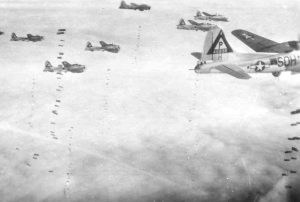 When a mistake is made in the air, it usually results in a disaster. Air disasters often involve the pilot, a mechanic, or an old part. Of course, some of the worst disasters were caused when an air traffic controller sent two planes to the same place at the same altitude. The resulting mid-air collision killed everyone on board. Mistakes are never good, but in the air they are especially devastating.
When a mistake is made in the air, it usually results in a disaster. Air disasters often involve the pilot, a mechanic, or an old part. Of course, some of the worst disasters were caused when an air traffic controller sent two planes to the same place at the same altitude. The resulting mid-air collision killed everyone on board. Mistakes are never good, but in the air they are especially devastating.
War is no different, in fact mistakes in war can be really disastrous. Gunners shooting at the enemy planes are often so focused that when the enemy flies past their own squadron, they can end up shooting down their own squadron members with friendly fire. 
The strange thing is that sometimes, a would be disaster ends up becoming one of the greatest miracles. Such was the case during World War II. The Americans planed a bombing run, and it was going to be a big bombing run. The orders had been issued. The problem…one squadron accidentally showed up thousands of feet lower down than the other one. In many cases, this would not have bee such a big problem, but both squadrons ended up a the drop site at the same time. The scheduled bombing began, and no one would really realize what was about to happen until it was too late.
Neither of the squadrons saw each other, until the bombs had been dropped. Miraculously, none of the lower planes were hit by the higher planes. It was a miracle of epic proportions. In addition, the Germans thought 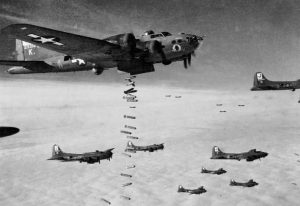 that the Allies had come up with an ingenious bombing strategy to bomb an area twice as much. After that bombing event, the Germans were scared that the Allies had this level of skill. It seemed completely impossible that they could plan a bomb run in which the lower planes flew in sync enough to allow the upper planes to drop their bombs in between the lower planes, while the lower planes were also dropping their bombs. It was impossible, and yet it happened. The impossible was achieved without one bit of planning. There is simply no other word for it. It was a miracle. God took a potential disaster and turned it into one of the greatest feats of warfare.
that the Allies had come up with an ingenious bombing strategy to bomb an area twice as much. After that bombing event, the Germans were scared that the Allies had this level of skill. It seemed completely impossible that they could plan a bomb run in which the lower planes flew in sync enough to allow the upper planes to drop their bombs in between the lower planes, while the lower planes were also dropping their bombs. It was impossible, and yet it happened. The impossible was achieved without one bit of planning. There is simply no other word for it. It was a miracle. God took a potential disaster and turned it into one of the greatest feats of warfare.

